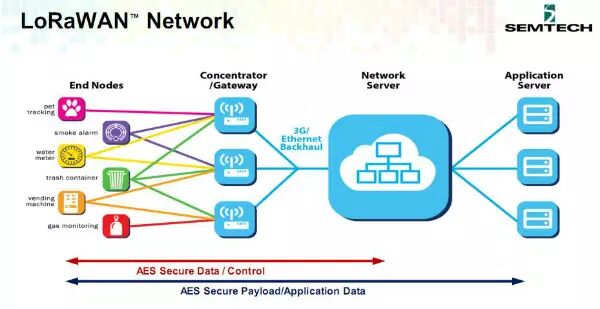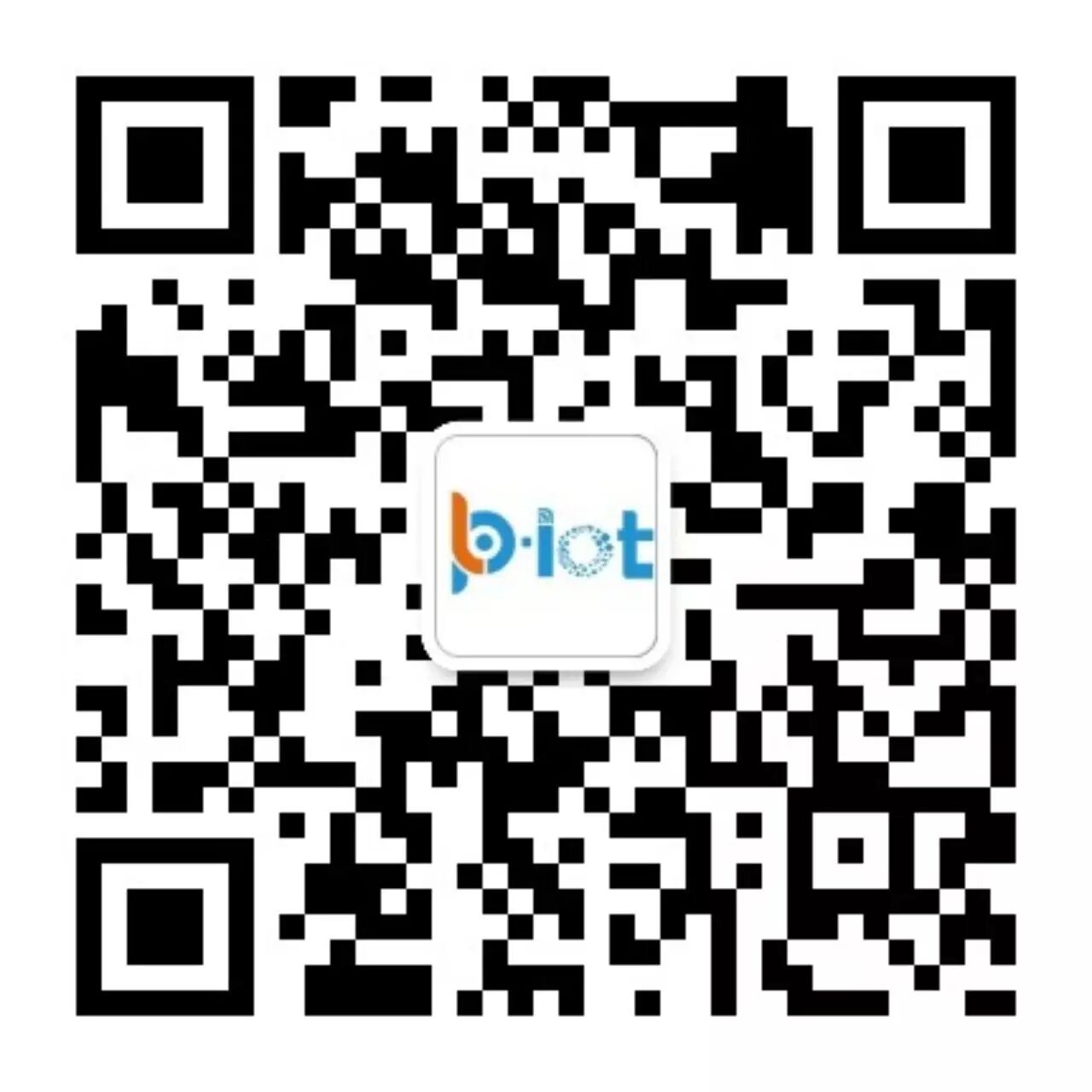LoRa&IoT
For Semtech, there is a seemingly “sweet” trouble.
That is, the recognition of their product LoRa far exceeds that of their company name Semtech.
However, the “awkward” part is not just this.
As two of the most promising low-power wide-area network communication technologies in China, NB-IoT and LoRa have always been compared, with many comments suggesting a “kill or be killed” sentiment. Some even ask Semtech, “How do you convince me to use your LoRa instead of NB-IoT?”

(LoRa network composition)
Semtech’s South China Regional Marketing Director, Mou Mingyue, was recently asked this question at an event in Guangzhou.
He admitted that simply stating the disadvantages of NB-IoT is meaningless. Semtech believes that in the future, LoRa will be deployed in a complementary manner with NB-IoT. One of the characteristics of LoRa is its low transmission power, which allows for a wider transmission range and distance. Semtech once placed a gateway on the roof of Cisco’s building in the U.S., and under unobstructed outdoor conditions, the LoRa signal could reach as far as 32 kilometers.
Why can it achieve such long-distance communication? Mou Mingyue explained that LoRa is based on linear spread spectrum modulation technology, with receiver sensitivity optimized by 36dB compared to FSK, meaning that LoRa signals can be 20dB lower than the background noise; and LoRa has a very high spectral modulation efficiency, which means less capacity loss for better link budget. LoRa operates in the sub-1GHz frequency band, where at the same sensitivity, 470MHz has nearly 10dB better penetration than 900MHz.

(LoRa’s actual transmission distance in the U.S. can reach as far as 32 kilometers)
 LoRa Second Generation Chips Will Open Up Positioning Functions
LoRa Second Generation Chips Will Open Up Positioning Functions
This feature extends LoRa’s application scenarios to smart agriculture. Currently, some agricultural irrigation projects in Chongqing, China, are using LoRa technology. Because sensors need to be buried deep enough to avoid being “mis-harmed” by cutting machines. With its low bandwidth, low power consumption, long distance, and low cost, LoRa has already been commercially implemented abroad.
In March 2015, the LoRa Alliance was announced, and currently, the alliance has over 500 members, while the CLAA alliance in China has attracted 700 companies and has conducted 100 applications.
The leader of this alliance is Semtech.
Dr. Yang Liu, Semtech’s Market Development Director, also publicly stated that LoRa entered the Chinese market early, initially promoted as a remote wireless metering technology solution, and later discovered that the applicable market for LoRa is vast.
Next, Semtech hopes to achieve urban-level coverage for LoRa in China. Mou Mingyue further revealed that by the end of this year, Semtech will establish an experimental site in China for roadshows, testing the second-generation LoRa chips with open positioning functions. From the current test results, the positioning accuracy of the second-generation LoRa chip is around 100 meters in static conditions.
 Market Competition: China Emphasizes IoT Security
Market Competition: China Emphasizes IoT Security
Currently, LoRa networks are being piloted or deployed in many parts of the world. According to data previously released by the LoRa Alliance, 46 operators are conducting corresponding network deployments, with LoRa networks already deployed or in the process of being deployed in over 350 cities. Among them, the U.S. network operator Senet completed the construction of 50 base stations in North America in mid-2015, covering 15,000 square miles (approximately 38,850 square kilometers), and expects to complete over 200 base stations in the first phase; France Telecom Orange announced the establishment of a network in France in early 2016; KPN of the Netherlands announced it will build a network in New Zealand, aiming for 50% coverage by 2016; Tata in India announced it will build a network in Mumbai and Delhi; Telstra announced a pilot in Melbourne…
Mou Mingyue also revealed that it is expected that this year, Semtech’s SX1278 chip shipments in China will exceed 10 million units.
Whether it is NB-IoT, supported by domestic operators, or LoRa, which has been successfully applied abroad, both are striving to penetrate the Chinese market.
However, the continuous emergence of IoT security issues this year has also attracted the attention of the Central Cyberspace Administration.
The peak forum of the 2017 Cybersecurity Week was held in mid-September in Shanghai, where Yang Xiaowei, Deputy Director of the Central Cyberspace Administration, called for increased research on the security of IoT, artificial intelligence, 5G, and more.
Regarding data security, Semtech claims that LoRa already has a relatively mature industrial chain in China. With the improvement of the entire LoRa ecosystem, there will be many supporting components such as various nodes, gateways, and servers. A typical school, hospital, or factory can use a LoRa gateway along with terminal nodes to build a private network, where all data can be kept private. Compared to other technologies, LoRa’s security can be guaranteed.
 Application Implementation: Nansha, Guangzhou Becomes a Pilot
Application Implementation: Nansha, Guangzhou Becomes a Pilot
Based on LoRa’s security mechanism, some domestic companies have unified control over network devices through IoT identification, aiming to ensure the security of all connected devices from the source, thus avoiding the access of illegal devices. Guangdong Zhongke Lupu Network Technology Co., Ltd., located in Nansha, Guangzhou, has actively promoted the deployment of low-power IoT networks since this year.
This high-tech enterprise incubated from the Computer Network Information Center of the Chinese Academy of Sciences in Guangzhou has launched a secure low-power communication network system called LoPo-IoT based on the LoRaWAN standard, combining the center’s own IoT identification technology. It is understood that the company has quickly achieved network deployment over 803 square kilometers in Nansha District, successfully creating the first low-power IoT application network covering the entire administrative region in China.
The company’s general manager, Huang Kaide, introduced that the specific applications of this network in Nansha, Guangzhou, include smart parking, garbage bin monitoring, well monitoring, environmental monitoring, asset management, and anti-loss measures for the elderly and children. Currently, the company team has deployed dozens of parking spaces in some scenic spots in Nansha, expected to be put into use during the National Day holiday.
In addition, he also stated that thanks to the location in Nansha, the open LoPo-IoT application management platform can rely on the network of Nansha District, integrating existing urban information systems such as video and e-government, forming an information management platform for urban IoT, thereby turning Nansha District into a successful model of a smart city.
“An interesting example is that when we tested the LoPo-IoT communication module on Guangzhou Metro Line 4, the average speed of Line 4 is over 40 kilometers per hour. Even at the highest speeds of 70 to 80 kilometers per hour, we found that the signal quality remained relatively stable. This indicates that the LoPo-IoT network supports applications with devices moving at low to medium speeds, which is one of the obvious characteristics that distinguish LoRa from NB-IoT.”
However, Huang Kaide also admitted that unlike NB-IoT, which has the backing of operators and local governments, they are currently feeling significant pressure from both internal and external sources while promoting the LoPo-IoT low-power IoT communication network based on the LoRa protocol. First, customers believe the technology has potential, but when it comes to specific deployment, there are still many concerns. Second, they hope that LoRa technology can break through successfully in China as soon as possible, enhancing public awareness of new technologies and increasing confidence in applications, thereby improving market space.
“It would be best if there were another phenomenon-level IoT application like shared bicycles, for example, smart parking applications, to give the industry a push.” Huang Kaide said.
Written by/池嘉仪
Reprinted from the Computer Network Information Center of the Chinese Academy of Sciences in Guangzhou

Long press the QR code to stay updated with industry dynamics